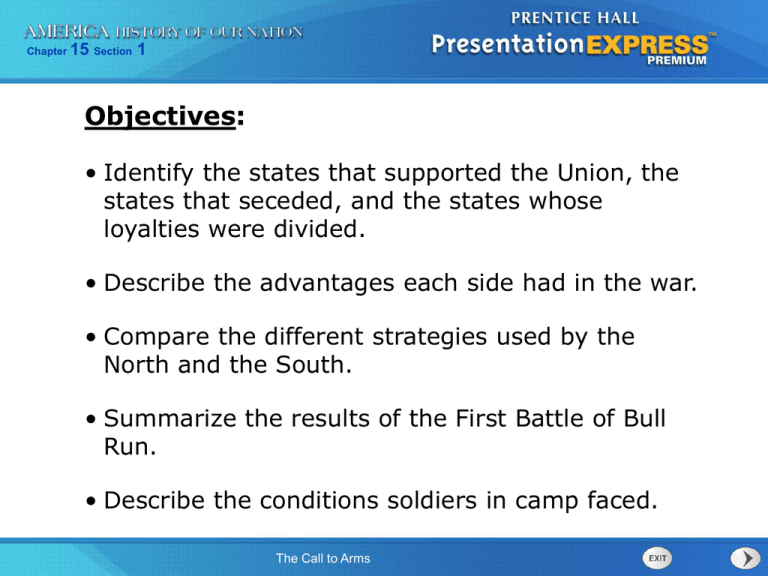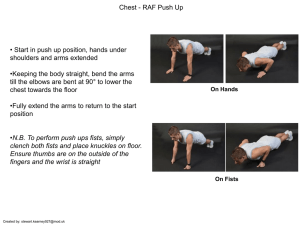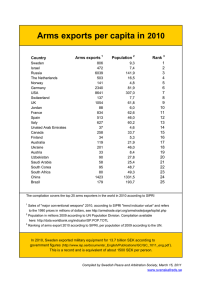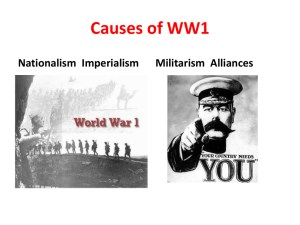Section 1 PowerPoint Notes
advertisement

Chapter 15 Section 1 Objectives: • Identify the states that supported the Union, the states that seceded, and the states whose loyalties were divided. • Describe the advantages each side had in the war. • Compare the different strategies used by the North and the South. • Summarize the results of the First Battle of Bull Run. • Describe the conditions soldiers in camp faced. The Call to Arms Chapter 15 Section 1 Terms and People: • border state – a slave state that did not secede • neutral – not favoring either side • martial law – a type of rule in which the military is in charge and citizens’ rights are suspended • blockade – a military action to prevent traffic from coming into an area or leaving it The Call to Arms Chapter 15 Section 1 Chapter 15 Section 1: The Call to Arms Learning Target: I can describe the advantages both sides had during the Civil War. The Call to Arms Chapter 15 Section 1 Warm Up Questions: 1. List one advantage the South had. 2. List one advantage the North had. 3. What is the North’s strategy? 4. What is the South’s strategy? 5. How does the Union plan to cut the South off from foreign trade? The Call to Arms Chapter 15 Section 1 Why did both the North and the South think they would easily win the war? Many Northerners and Southerners were confident that their side would win a quick victory. The North had a greater population and more resources. The Call to Arms The South had a more experienced military. Chapter 15 Section 1 The Call to Arms Chapter 15 Section 1 The Call to Arms Chapter 15 Section 1 The Call to Arms Chapter 15 Section 1 The Call to Arms Chapter 15 Section 1 Creation of West Virginia After the attack on Fort Sumter, President Lincoln asked states to send troops to end what he called a “rebellion.” This caused more southern states to secede. The western counties of Virginia refused to secede. These joined the Union as the state of West Virginia. The Call to Arms Chapter 15 Section 1 The Border States A key question at the start of the war was whether border states would side with the Union or the Confederacy. Both sides wanted to control the Ohio and Mississippi Rivers. The Call to Arms Chapter 15 Section 1 Four border states did not secede: Delaware Delaware supported the Union. Kentucky Kentucky started out neutral. After it was invaded by southern troops, Kentucky supported the Union. Missouri President Lincoln used force to keep Missouri in the Union. Maryland Lincoln placed Maryland under martial law to keep it in the Union. The Call to Arms Chapter 15 Section 1 Northern Advantages The North was confident that it would win the war by taking advantage of its resources. These included: a larger population more acres of farmland more factories more railroad tracks The North was able to field, feed, and equip larger armies. The Call to Arms Chapter 15 Section 1 The Union had an advantage over the Confederacy in its amount of resources. The Call to Arms Chapter 15 Section 1 Southern Advantages On the other hand, the South had the advantage of land. The North would have to invade land with which they were not familiar. Also, three generals, including Robert E. Lee, had resigned from the U.S. Army to help the South. The Call to Arms Robert E. Lee Chapter 15 Section 1 The North’s Strategy The North planned a multi-part strategy to defeat the South. • Blockade southern ports. • Seize Richmond. • Gain control of the Mississippi River and split the South in two. The Call to Arms Chapter 15 Section 1 The Southern Strategy The South had a simpler strategy. They only needed to defend their land until the Northern armies got tired of fighting. The Call to Arms They also sought help from Britain and other European nations that relied on the South for cotton. Chapter 15 Section 1 When the Civil War began, thousands of soldiers volunteered for the Union and Confederate armies. Many of these soldiers were young and inexperienced. The Call to Arms Chapter 15 Section 1 Conditions for Soldiers Life in an army camp was harsh. Soldiers faced boredom, disease, and even death. Camps were filthy and lacked clean water. Outbreaks of diseases swept through the ranks. Captured soldiers were placed in overcrowded prison camps. Thousands died from starvation or exposure. The Call to Arms Chapter 15 Section 1 The Call to Arms Chapter 15 Section 1 The Call to Arms Chapter 15 Section 1 The Call to Arms Chapter 15 Section 1 The Call to Arms Chapter 15 Section 1 First Battle of Bull Run Because many soldiers were unskilled, Union General Irvin McDowell wanted time to train his men. However, in the north, newspapers called for a quick end to the war. Union soldiers marched towards Richmond. During the First Battle of Bull Run, Confederate general “Stonewall” Jackson and his men held firm. The Call to Arms Chapter 15 Section 1 Inexperienced Union soldiers panicked and then retreated, but the Confederates were too exhausted to pursue them. Bull Run was an early sign that the war would be long and costly. The Call to Arms Chapter 15 Section 1 The Call to Arms Chapter 15 Section 1 Closing Questions: Answer each question by yourself in 2-3 COMPLETE sentences. 1. Knowing the advantages of each side who do you think had a better chance of winning the war? Explain. 2. What would have happened if the North would not have been able to cut off the South from foreign trade? How would this have affected the outcome of the war? The Call to Arms Chapter 15 Section 1 Closing Questions: Honors Answer each question by yourself in 3-4 COMPLETE sentences. 1. Knowing the advantages of each side who do you think had a better chance of winning the war? Explain. 2. What would have happened if the North would not have been able to cut off the South from foreign trade? How would this have affected the outcome of the war? The Call to Arms Chapter 15 Section 1 Section Review QuickTake Quiz The Call to Arms Know It, Show It Quiz










